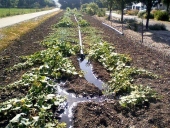I think this is a topic that has more confusion than accuracy.
I saw one post that suggested a pyramidal windbreak, which would actually act more like an airplane wing, and then the poster rescinded that idea a few posts later!
There's one version of the story that a windbreak absorbs energy (trees do by turning that energy into movement--in the process drying out perhaps but still better them than my annuals/small plants). This makes sense. But then there's also the need for instant windbreak, enough to get a toehold in a spot where a windbreak tree isn't yet willing to try to make its fortune.
Can wind be lifted up off the ground or not? how has this been actually measured? how much is just wisdom handed down or US Dept. or Ag. documents (I imagine these aren't bothering to cite studies, they said grow shelterbelts and we stopped having the Dustbowl, so good enough?).
I like the idea of building them with an excavator--but that's only an idea if I don't have the excavator.
And then there's tensegrity...
https://www.iaacblog.com/programs/windbreak-tensegrity-structure/
This seems really cool, if quite an artificial implementation. It appears surprisingly effective, if I'm reading the results right. But I don't want to use these kinds of materials in my landscape, at least not more than briefly. (Maybe it helps us to return whence we began and know the tree for the first time.)
There is also plenty that science does not yet understand. And there's much that can't be isolated from other factors--e.g., a tree that is part of a forest thrives much more because of the many benefits of forest membership, not solely from the wind protection plan.
In doing some Green Hat (de Bono) thinking about this subject I came up with some new, even-lazier ideas, but I don't have enough conceptual understanding to know for sure if my ideas are good or not. One was to half-bury brush in a trench and half-berm on top of the brush, the bottom half is now really out of the wind and able to retain moisture in the soil in its crevices.
What are some of the best sources on windbreaks that cite actual evidence, and include both mathematics and observation?
I'd like to have a thread that gives the basics and makes a solid overview. A basis from which one can assess other sources of information.






